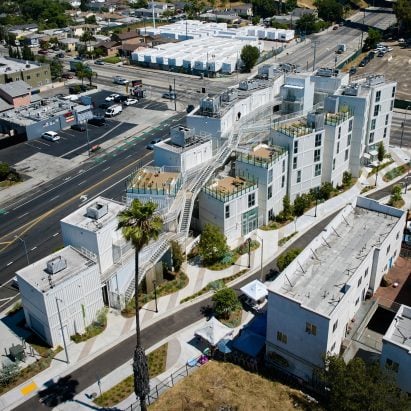Architecture studio LOHA has completed Isla Intersections, a low-cost housing complex for formerly homeless residents that comprises stacked shipping containers and sits on a triangular site near a busy highway interchange.
Encompassing 35,000 square feet (3,252 square metres), the complex contains 54 supportive housing units, along with gardens and space for job training and creative programming.
LOHA has completed Isla Intersections, a low-cost housing complex in Los Angeles for formerly homeless residents
The building offers rental units for tenants who were formerly unhoused.
Located in South LA near a junction of highways, the building sits on a strip of land that was formerly a traffic median.
White staggered boxes were loosely organised around an interior courtyard
“Situated within close proximity to one of the world’s busiest freeway interchanges – the meeting of the 110 and 105 freeways – the design makes a challenging location more liveable,” said local studio LOHA, or Lorcan O’Herlihy Architects.
The site, which is just under a half-acre, is one of many city-owned parcels made available by the City of Los Angeles in 2018 to developers of affordable housing.
The building sits on a strip of land that formerly was a traffic median
Many of the parcels are challenging, as they sit along heavy traffic corridors or next to freeways, or are a composite of parcels that have been “left untouched for decades”.
“It is in this kind of liminal space, fraught with ambiguity, that we see opportunity, and a potentially significant next step for the future of housing in the city,” said LOHA .
Each tower varies in height
“Our foray into this challenging yet exciting area has us working as architects and urban strategists.”
Isla Intersections consists of white staggered boxes, most of which are loosely organised around an interior courtyard. Apartments are arrayed along corridors lined with metal railings.
The apartments are designed to be efficient and compact
“The towers are intentionally scattered along the pie-shaped edge of the property, enclosing a sequence of small green spaces that provide surprising moments connecting the landscape to the private residences,” the team said.
The height of each tower varies, depending on the immediate context.
They are arrayed along corridors lined with metal railings
As the building approaches a single-family neighbourhood to the north, it steps down from five storeys to two. Along the western elevation, the building is lower in height to blend with a walkway called Annenberg Paseo that winds along the street.
The paseo forms a “slow space” that prioritises pedestrians and bikers, the team said.
Each tower was built using new steel shipping containers
“The ground level along the paseo will provide a number of storefront spaces for retail, incubation and job training and support services, as well as administrative offices,” the team said.
“This marketplace and paseo will also serve as a ‘living lung’, helping to filter diesel particulates and air pollutants.”
Each apartment is composed of three containers that were welded together to a single 480-square-foot unit
Each tower was built using new steel shipping containers, which were transported to the site via a flatbed truck. Each apartment is composed of three containers that were welded together to create a single 480-square-foot (45 square metres) unit.
The project’s modular approach, combined with the ability to work both on- and off-site, reduced the overall construction time from 45 to 30 months.
The project also incorporates rooftop farms
The apartments are designed to be efficient and compact. Each comes furnished and offers a bedroom, kitchen, living room, dining space and bathroom. Simple finishes include drywall and vinyl-wood flooring.
The project also incorporates rooftop farms and edible gardens that are intended to supply produce for farmers’ markets.
“This project also has the chance to become part of a larger network of urban farms in the area, whose mission is to preserve the tradition of farming in South Los Angeles, bringing affordable produce to what many consider a food desert,” the team said.
Near Isla Intersections is the well-known Stanford Avalon Community Garden, a nine-acre urban farm located under power lines in the Watts neighbourhood and cared for by local residents.
Plans for the Isla Intersections project were revealed by Dezeen in 2019
“Isla aspires to build on [Stanford Avalon Community Garden’s] legacy, harnessing the potential to be a part of a much larger living lung that can potentially wind its way through the city,” the team said.
Plans for the Isla Intersections project were revealed by Dezeen in 2019, and the project was completed last year.
It marks the second collaboration between LOHA and the non-profit developer Holos Communities
“Our aim was to create something that was compartmental but solid – strong enough to withstand the demands of the project’s location but porous enough to engage the residents on a human scale with outdoor activities and places to work and socialize,” said LOHA.
It marks the second collaboration between LOHA and the non-profit developer Holos Communities, the other being an affordable housing project called MLK1101.
Other affordable and supportive housing projects in LA include a complex by Patrick Tighe and John Mutlow that is wrapped in large white ribbons, and an apartment building by Brooks + Scarpa that features a scalloped, textured facade.
The photography is by Eric Staudenmaier.
Project credits:
Architect: LOHA (Lorcan O’Herlihy Architects)
Team: Lorcan O’Herlihy (principal-in-charge), Abel Garcia (team lead), Ian Dickenson, Yuval Borochov, Huizhen Ng, Kathryn Sonnabend, Santiago Tolosa
Client: Holos Communities
The post LOHA creates affordable housing on challenging site in Los Angeles appeared first on Dezeen.
